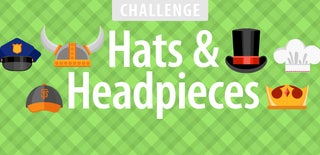Introduction: Pacha
Pacha, the village leader and reluctant travel companion of the Emperor. This is a great costume, especially for a group. You can see my other instructable for Emperor Kuzco here: https://www.instructables.com/id/Emperor-Kuzco/.
This costume is super simple to make, and easy to wear.
Step 1: Materials
For this costume, we'll need a bit of fabric.
Pancho:
- I fleece. About 2 yards of light green .
- Just over half a yard of dark green for the trim
- Gold or yellow trim (I just used thin ribbon)
Shirt:
- 2 yards of white muslin (I liked the cheap look), though cotton is fine
Skirt and hat:
- 2-3 yards of brown flannel.
- Elastic for the waistband.
Accessories:
- Brown sandals
Step 2: Poncho: Design It
There are only a couple of measurements you need.
- Spread our your arms and measure from finger tip to finger tip.
- Measure the width of the base of your neck (for the head hole)
Designing the Main Part
MATH WARNING AHEAD!
1) The main part of the poncho is formed from a square where the diagonal length should be your arm span measurement (let's call this A). This means to get the length of the sides of the squares is computed by this formula: Side = sqrt(A2/2)
For example, I have an arm span of 73 inches, so:
732 = 5329
5329/2 = 2664.5
sqrt(2664.5) = 51.62
I then round these numbers up to the nearest inch, so that would mean the sides of my poncho are 52 inches.
2) With the square, designate one corner to be the front, the opposite the back and the other two as the sides
3) Round out the side corners.
4) Mark the center and draw a circle with a diameter that matches the neck measurement.
5) Square out the neck hold circle on one corner to match the front corner.
Designing the Trim
1) Start with a hole that matches the head hole on the main part
2) Draw out about 4 inches from that
Step 3: Pancho: Sew It
1) Measure 5/8 inch around the trim and fold it over. Iron it down in place.
2) With the front of the trim lying on the back of the main piece (so that the ironed part of the trim faces outwards), sew around the neck hole. Trim around seam and clip on the curves.
3) Pull the trim through the head hole so that the seam is now hidden. Iron it down flat.
4) Top stitch near the edge of the outside of the trim to stick it down.
5) Stitch down the gold ribbon around the edge of the green trim.
6) Stitch a rolled hem around the main part of the poncho.
Step 4: Shirt
First, the measurements required for the shirt.
- About halfway down the upper arm to the other side (about where a short sleeve shirt would end). Lets call it arm span.
- Width of the base of the neck
- Height of the arm holes
- Top of the shoulder to a few inches below the belt line (how tall you want the shirt). Lets call this shirt length.
The shirt is really simple. You will cut our two rectangles with a width that is the arm span, and a length that is the shirt length, plus 1.25 inch for seam allowance.
1) Sew the rectangles together at the shoulders and the sides leaving open the neck hole and arm holes.
2) Cut a two inch slit down the front middle of the head hole. fold in the flaps
3) Sew a basic rolled hem around the neck and arm holes, and finish the bottom hem however you prefer. I just serged around it, since it will be tucked into the skirt.
Step 5: Skirt
Two measurements for this one:
- Measure around the widest part of you hips
- Measure from the belt line down to your knee
The pattern is again two rectangles. The width is about half your hip measurement plus 3 inches. To get the length, first you need to measure the width of your waistband elastic. Mine was 1". So I took my belt to knee measurement, added the width of the elastic and another .5" for a seam. Then add length for a hem on the bottom if you like. I actually left the bottom of mine without the hem, because I liked the unfinished look. Made it seem rougher.
1) Sew the sides of the skirt together
2) Fold down the top of the skirt to the inside to make a case for the elastic. Sew it down leaving a small opening in the back that you can slide the elastic into.
3) Insert the elastic. Before cutting it, try it on and pin it to a comfortable level. Then stitch the elastic ends together. For additional help, there are plenty of tutorials out there on sewing an elastic waistband. Look at a few of them if you have never done one before.
Step 6: Hat
The measurements for the hat are a little more difficult:
- Put a square on your head (or pretend you have one) and measure from the back of your head to however far forward you want the hat to go. I went just in front of the ears. Then measure from the top of your head to how far you want it to go down in the back.
- From the front of your head, start in the middle and measure down the side for however for you want it to hang in the front.
- Now find a rough measurement for the bottom of the hat (starting from the middle of your neck) to the bottom front corner.
You will take these four measurements and make a four-sided object with them.
1) Make a square that is the top and back measurements.
2) Now match up the front and bottom sides until you approximately the right lengths for both. One way to do this is you draw two arches each going the length of the side, then find where the two arches intersect
3) Round out the top and back corners to ensure that the edge is 90 degrees. This is important when sewing the two halves of the hat together to ensure that where they halves meet up is smooth.
4) Add a bump to the top back.
5) Add a 5/8" seam allowance around the whole thing.
I would strongly suggest mocking up the hat from a cheap fabric, or even paper, first to ensure that it looks right and fits nicely. Once you are happy with the design, the two halves out of your brown fabric, then sew them together. I just did a basic rolled hem around the front and bottom to finish it off.
Step 7: Finish It Up
Now all you have to do is slap on some sandals and hunt down your favorite llama and you are ready to go! It's an easy costume to make and easy to wear. Which is always great in my book.

Participated in the
Halloween Costume Contest 2016

Participated in the
Hats and Headpieces Challenge











